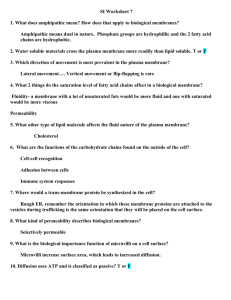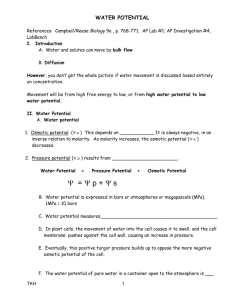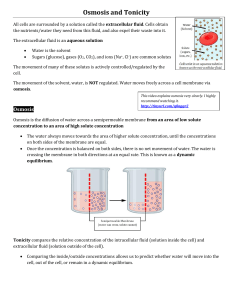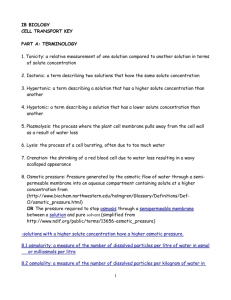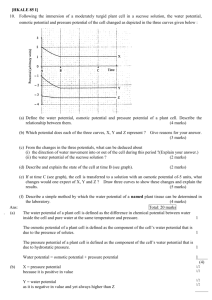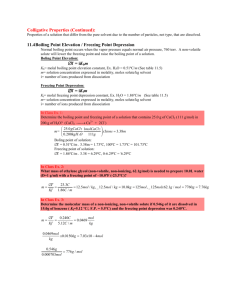How big are osmotic and turgor pressures in cells?
advertisement
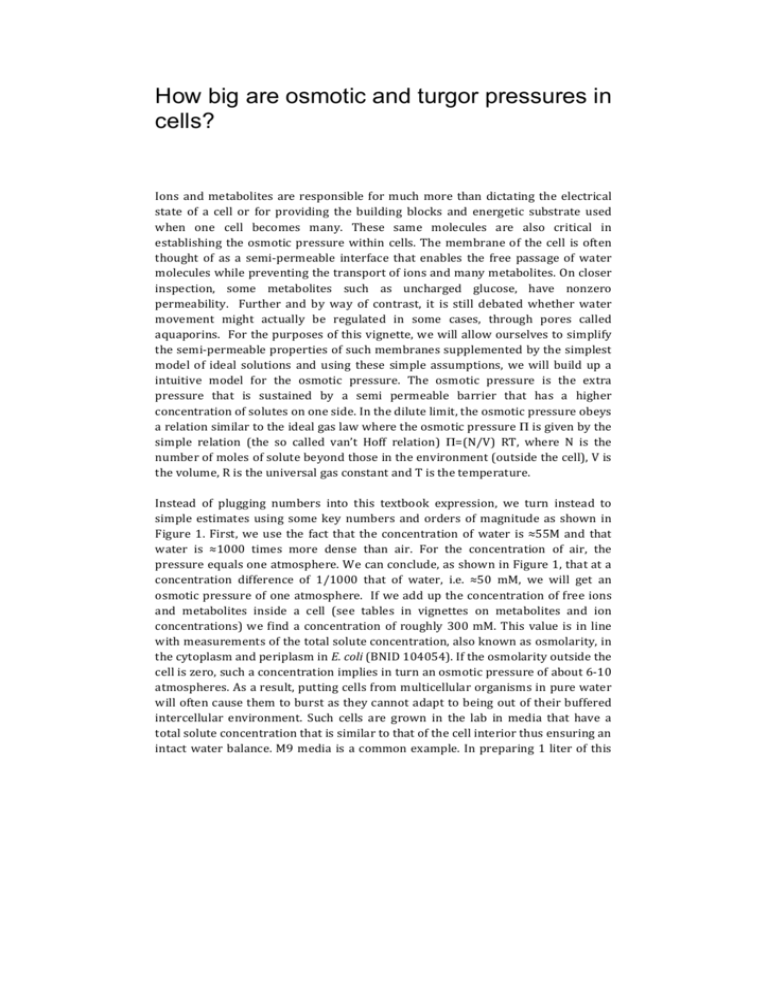
How big are osmotic and turgor pressures in cells? Ions and metabolites are responsible for much more than dictating the electrical state of a cell or for providing the building blocks and energetic substrate used when one cell becomes many. These same molecules are also critical in establishing the osmotic pressure within cells. The membrane of the cell is often thought of as a semi-­‐permeable interface that enables the free passage of water molecules while preventing the transport of ions and many metabolites. On closer inspection, some metabolites such as uncharged glucose, have nonzero permeability. Further and by way of contrast, it is still debated whether water movement might actually be regulated in some cases, through pores called aquaporins. For the purposes of this vignette, we will allow ourselves to simplify the semi-­‐permeable properties of such membranes supplemented by the simplest model of ideal solutions and using these simple assumptions, we will build up a intuitive model for the osmotic pressure. The osmotic pressure is the extra pressure that is sustained by a semi permeable barrier that has a higher concentration of solutes on one side. In the dilute limit, the osmotic pressure obeys a relation similar to the ideal gas law where the osmotic pressure Π is given by the simple relation (the so called van’t Hoff relation) Π=(N/V) RT, where N is the number of moles of solute beyond those in the environment (outside the cell), V is the volume, R is the universal gas constant and T is the temperature. Instead of plugging numbers into this textbook expression, we turn instead to simple estimates using some key numbers and orders of magnitude as shown in Figure 1. First, we use the fact that the concentration of water is ≈55M and that water is ≈1000 times more dense than air. For the concentration of air, the pressure equals one atmosphere. We can conclude, as shown in Figure 1, that at a concentration difference of 1/1000 that of water, i.e. ≈50 mM, we will get an osmotic pressure of one atmosphere. If we add up the concentration of free ions and metabolites inside a cell (see tables in vignettes on metabolites and ion concentrations) we find a concentration of roughly 300 mM. This value is in line with measurements of the total solute concentration, also known as osmolarity, in the cytoplasm and periplasm in E. coli (BNID 104054). If the osmolarity outside the cell is zero, such a concentration implies in turn an osmotic pressure of about 6-­‐10 atmospheres. As a result, putting cells from multicellular organisms in pure water will often cause them to burst as they cannot adapt to being out of their buffered intercellular environment. Such cells are grown in the lab in media that have a total solute concentration that is similar to that of the cell interior thus ensuring an intact water balance. M9 media is a common example. In preparing 1 liter of this media one uses a salt recipe with the major component being 13g of Na2HPO4•7H2O whose molecular mass is 300 g/mol. So the concentration is (13 g/l)/(300 g/mol)≈20 mM and each dissolved molecule will give about five ionic charges, two as Na+ and three in PO4-­‐3. So the osmolarity from this component is about 100 mOsm. Adding the other minor components leads to a total of about 200 mOsm. Bacteria and plants are usually able to withstand the kinds of pressure difference estimated above due to their pressure-­‐resisting cell walls. In plants, the osmotic pressure, also known as turgor pressure, plays a key part in shaping the posture and enabling movement of these mostly sessile organisms – the turgor pressure dictates if our home plants wilt or stand tall and enables the Venus flytrap to snap within 100 ms (BNID 106630) to capture insects as a dietary supplement. When E. coli is suspended in pure water with negligible osmotic pressure outside the internal osmolarity is seen to decrease to about 170mOsm (equivalent to units of mM, BNID 108561) and then the bacterial cell wall withstands a net pressure of 3-­‐ 4 atmospheres (BNID 104056). The ability to resist pressure is related to the Young modulus, a measure of the elastic “strength” of a material. Membranes have relatively low Young’s modulus in comparison to the materials used to build bone and teeth or the cell wall discussed below, and thus the membrane cannot resist significant pressure differences. As a result, the pressure in two compartments separated by only a membrane must be nearly equal. Examples are in bacteria the cytoplasm and periplasm separated by the inner plasma membrane, in plants the cytoplasm and vacuole separated by the tonoplast membrane and in mammalian cells the cytoplasm and the intercellular medium separated by the cell outer membrane. Cell walls on the other hand have a Young’s modulus several orders of magnitude larger (≈1 GPa, BNID 108535) and can resist more substantial pressure differences like those found in plants and bacteria drifting in fresh lakes as discussed below. More quantitatively, membranes have critical rupture strengths (tensile strength) limited to stresses of 0.2-­‐1 MPa (BNID 108544). For a spherical vacuole of about 10 µm radius this will occur when the difference in pressure is 0.01 atmospheres (BNID 108553). Using the relation between osmotic pressure and solute concentration above, we find that an imbalance as small as 0.5 mM can cause rupture. This unfortunate outcome is obviated by water flow changing a compartment volume and its solute concentration as well as active regulation by pumping of osmolytes to readjust the imbalance. In contrast, the osmotic pressure produced by the sap produced in mature leaves is usually about 0.6-­‐3 MPa (BNID 108540), i.e. 6-­‐30 atmospheres. Such a pressure is resisted by the cell wall. Similarly, bacteria with characteristic internal osmolyte concentration of 300 mM (or more accurately the unit should be mOsm) thrown into fresh water will have about 5 atmospheres of osmotic pressure to resist and will do so by their inner plasma membrane expanding and pressing against the cell wall that can resist such stress. In resisting applied pressures cell walls expand slightly with a characteristic value of about 1% expansion of the engulfed volume per one atmosphere increase in pressure due to the higher osmolarity of the cytoplasm (BNID 108537). relating solute concentration to osmotic pressure water kg 1 L 55 M air g 1L 50 mM solute 1/1000 of water conc air conc 1 Atm osmotic pressure 1 Atm pressure air density 1/1000 of water Figure 1: Rule of thumb for the correspondence between extra solute concentration in the cell interior versus the environment and the resulting osmotic pressure.


